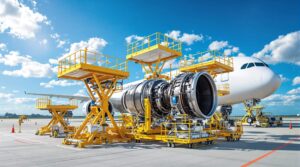The composition of aircraft flares involves a meticulous blend of chemicals designed to produce intense heat and light upon ignition. Typically, a flare consists of a combustible composition encapsulated in a casing. The composition includes a combination of oxidizers, fuels, and other additives to achieve the desired pyrotechnic effect.
One of the key components in the composition is a powdered oxidizer such as strontium nitrate or barium nitrate. These substances facilitate the combustion process by providing oxygen, essential for the flare to burn brightly. Additionally, metallic fuels like magnesium or aluminum are incorporated to intensify the brightness of the flare.
The casing of the flare is typically made of a material that withstands the intense heat generated during combustion. Aluminum is a common choice due to its lightweight and durable properties. The casing not only protects the composition but also assists in dispersing the ignited flare effectively.
The primary purpose of aircraft flares is to divert the attention of incoming heat-seeking missiles away from the aircraft. When a missile is launched, its infrared homing system targets the heat emitted by the aircraft engines. The flare, upon deployment, generates a sudden burst of intense heat, confusing the missile’s tracking system and causing it to follow the flare’s heat signature instead.
The deployment mechanism of aircraft flares varies, with some activated manually by the pilot and others relying on automated systems linked to the aircraft’s defense suite. Modern aircraft are equipped with advanced sensors that detect incoming missiles and trigger the release of flares in a timely and efficient manner.
Aircraft flares magnesium metal burning composition and purpose
Aircraft flares are essential safety devices designed to divert threats and protect aircraft from guided missiles during flight. The core composition of these flares often involves magnesium metal, known for its intense brightness when ignited. The burning composition typically consists of a mixture of magnesium powder, an oxidizer like potassium perchlorate, and a binder to hold the components together.
The key purpose of incorporating magnesium in aircraft flares lies in its ability to produce a brilliant white light when burned. This intense light emission serves two primary functions: countermeasure and illumination. As a countermeasure, the bright flare can decoy infrared-guided missiles away from the aircraft, diverting the heat-seeking projectiles towards the light source instead of the aircraft’s engine heat.
The composition’s ignition process is carefully controlled, often initiated by an electrically activated fuze. Once ignited, the magnesium metal reacts with the oxidizer, resulting in a dazzling display of light that can reach temperatures of over 2,000 degrees Celsius. This extreme heat not only creates a visually disruptive effect but also generates a thermal signature that draws away the homing mechanism of infrared-guided missiles.
The use of magnesium in flares is strategically significant due to its high ignition temperature and efficient energy release. The intense white light produced by burning magnesium serves as an effective defensive measure against both heat-seeking and visually guided missiles. This capability is particularly crucial during military operations, where aircraft may encounter various threats.
In addition to their countermeasure function, aircraft flares with magnesium composition also serve as valuable tools for illumination during nighttime operations. The intense light emitted not only provides a tactical advantage by illuminating the surrounding area but also aids pilots in maintaining situational awareness during low-light conditions.
It’s noteworthy that while the use of magnesium enhances the effectiveness of aircraft flares, safety precautions are paramount. Magnesium burns at extremely high temperatures and can pose risks if mishandled. The development and deployment of these flares involve rigorous testing and adherence to safety standards to ensure their reliable performance without compromising the safety of the aircraft and its crew.
Aircraft flares pyrotechnic mixture burning fallout contamination
Aircraft flares play a crucial role in enhancing the survivability of military aircraft during combat situations. These pyrotechnic devices release a specialized mixture of chemicals that generate intense heat and light, diverting heat-seeking missiles away from the aircraft. While these flares are instrumental in evading threats, their usage comes with a set of concerns, particularly regarding fallout and potential environmental contamination.
The pyrotechnic mixture used in aircraft flares is a precisely engineered composition of energetic materials. These substances, when ignited, create a controlled burst of intense heat and light. However, the aftermath involves the release of residues, commonly referred to as fallout. This fallout consists of unburned particles, combustion by-products, and remnants of the pyrotechnic mixture, posing challenges related to environmental contamination.
One of the primary concerns associated with the fallout from aircraft flare usage is the potential for contamination of soil, water bodies, and vegetation in the vicinity. The pyrotechnic mixture may contain chemicals that, if not properly managed, can have adverse effects on ecosystems. Mitigating these environmental impacts requires a comprehensive understanding of the composition of the pyrotechnic mixture and its potential interactions with the environment.
The extent of contamination risk depends on various factors, including the altitude at which the flares are deployed, prevailing weather conditions, and the type of terrain below. A systematic assessment of these factors is crucial for evaluating the potential ecological consequences of aircraft flare usage. Research efforts are ongoing to develop flare compositions that minimize contamination and reduce environmental impacts without compromising the flares’ effectiveness in thwarting threats.
Efforts to address contamination concerns involve the development of environmentally friendly pyrotechnic mixtures that degrade more rapidly and pose fewer risks to ecosystems. Additionally, strategic deployment practices are being explored to minimize the fallout’s impact on sensitive areas, such as water sources and protected habitats.
Toxic chemicals in aircraft flares and environmental impact
In the realm of aviation, aircraft flares play a crucial role in ensuring safety and survival. These pyrotechnic devices, although vital for military and civilian aircraft, contain toxic chemicals that raise concerns about their environmental impact.
The primary chemical of concern in aircraft flares is hexachloroethane, often used in smoke-generating formulations. When deployed, these flares release not only smoke but also trace amounts of toxic byproducts, including chlorine gas. The impact of these substances on the environment can be far-reaching.
One facet of the environmental impact is the potential harm to ecosystems surrounding training or conflict zones where flares are extensively used. The released toxic chemicals can contaminate soil and water, affecting flora and fauna. The persistence of certain chemicals in the environment exacerbates this issue.
Studies have shown that the toxic residues from aircraft flares can infiltrate aquatic systems, posing a threat to aquatic life. The ingestion of these chemicals by marine organisms can lead to bioaccumulation, further amplifying the environmental impact up the food chain.
Moreover, the combustion of toxic chemicals in flares releases greenhouse gases, contributing to air pollution and climate change. While the quantities may be relatively small on an individual basis, the cumulative impact from widespread use raises concerns, especially in sensitive ecological areas.
To address these concerns, efforts are underway to develop environmentally friendly alternatives for aircraft flares. Research focuses on finding formulations that maintain operational effectiveness while minimizing toxic byproducts. The goal is to strike a balance between the necessities of aviation safety and reducing the environmental impact of military and civilian activities.






